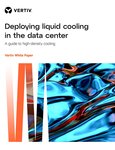Data centers are complex energy-demanding environments. The number of data centers and their energy consumption around the world is growing at a rapid rate. Several trends are shaping future data network electricity use. Global internet traffic, for example, more than doubled between 2017 and 2020 and will possibly double again by 2023 if current trends continue. By 2025, data centers are forecast to consume more than two percent of the global electricity supply. As such, there’s an urgent need to design data centers in a way that makes them as energy efficient as possible, especially as many data center operators have committed to becoming net zero carbon by 2030.
A major part of the total energy consumption in data centers results from cooling servers and related equipment. To ensure cooling can take place in a more sustainable, energy efficient way and help to reduce the total energy consumption of data centers, the complex and critical nature of data centers requires in-depth investigation. One tool that’s particularly beneficial in achieving this in data center applications is computational fluid dynamics (CFD). CFD is the study of fluid behaviour with the help of computers by solving complex numerical algorithms to predict fluid flow and heat transfer.
The key role of CFD analysis is to deliver an efficient design solution where a data center can operate normally and productively at a low Power Usage Effectiveness (PUE).
CFD benefits
By using CFD, engineers can analyze the data center airflow management and data center design in much more detail and also at an early stage in the design process. If the airflow and equipment location and selection is not managed properly, this has the potential to result in reduced efficiency of equipment, design capacities not being achieved and possible downtime and, eventually, damaged and inadequate IT equipment. However, through using CFD in data center design and particularly early in the design process, data center operators can save time and money. This is because, through CFD, we can predict the future outcome of design decisions. For example, CFD provides detailed design insights which can tell you, before the data center is built and the IT equipment is in place, how key aspects of the data center and critical equipment will perform. This can enable you to identify potential design challenges to overcome, reduce design mitigations, streamline data center performance and ultimately assist in improving PUE. At B&W, we have experienced and skilled CFD experts who have tremendous knowledge about the data center industry which, in turn, has enabled us to deliver very low PUE data center consultancy projects globally.
The road to net zero carbon
CFD providers understand the urgency of achieving net zero carbon and, this year, they have added additional features to CFD packages which make net zero carbon targets possible. For example, simulations of the internal and external view of a data center by using CFD software have become quite common in the datacenter industry, with rapid developments in numerical models and computational power in the last decade.
Previously, CFD packages only allowed an airflow-management based solver. This year, however, there have been incredibly significant upgrades made in CFD package providers such as Future Facilities, now Cadence. The 6SigmaDCX sets a new milestone in energy efficient data centers by offering a wide range of features to enhance data center design and operations. Engineering firms are adapting to these upgrades to deliver enhanced view developments which enable users to highlight graphic realistic results in reports, animation creation and faster, more detailed thermal flow analysis of the liquid and air flow routes. Other upgrades in areas such as energy-efficient models and integrated data center operating systems have also taken the importance of CFD to another level. Energy efficiency should now be the key factor in any data center design and embedded code for PUE calculation via internal and external CFD simulations are vital to achieving the lowest PUE that is possible. Also, integrating the CFD model into the real-time performance of Data center Infrastructure Management (DCIM) is crucial to modifying the head loads location in data centers in order to achieve high energy efficiency within it.
Looking ahead
As computing speeds increase and hardware costs drop, CFD will become more integrated into data center design and real-life monitoring systems. It will be used in real time analysis to simulate dynamic models of data centers based on the realistic data input from data centers. As the majority of energy consumption in a typical data center results from cooling equipment, it means CFD plays a vital role in analysing the airflow management within the data center and reducing the energy consumption in cooling. For data centers to truly succeed at becoming net zero carbon, and become part of the green revolution, their design, directed by CFD capabilities, must be at the core of any energy efficiency strategy.





